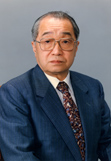|  
back
 |
Susumu KATO
Kyoto University
“The Earth’s Atmosphere in Vertical Dynamic-Coupling - The role of tides, gravity waves and turbulence” |
Abstract
The first idea about vertical dynamic- coupling of the atmosphere dates back to 19th century. The idea is that the atmospheric tides once excited near the ground, travel upwards, reaching the upper-atmosphere. In the upper-atmosphere tidal winds interact with the geomagnetic field producing electro-motive force, driving electric currents, thereby producing the Sq (quiet-day solar daily geomagnetic-variation) which is observed on the ground. However, this fantastic idea on the tidal wave propagating up to such a high altitude did present a serious problem in the 1950s. An inconsistency was found between tides observed on the ground and those deduced from the Sq in the upper-atmosphere. Solution of the inconsistency paved the way for establishing the Classical Tidal Theory which remains the basis of understanding of all global atmospheric waves as tides and planetary waves. Further development of tidal studies depends on numerical simulation and now powerful GCM reproducing various real complications.
In the 1950s gravity waves (GWs) were found to be as important in the vertical dynamic coupling as tides disturbing the ionosphere. In the 1980s it was further found that GWs break into turbulence, releasing momentum, thereby accelerating winds, while traveling upward, after excited in the lower atmosphere, with the amplified amplitudes. This implies that the GW breaking produces turbulence at any height. Tides also may behave similarly.
Turbulence perturbs radio-refractive index of the atmosphere, resulting in scattering of radar pulses, the turbulence behavior, which is basic for radar observation. On this basis suitable radars were constructed in some locations in the 1980s. Most powerful is the middle and upper atmosphere radar, MU radar, in Japan and geophysically unique is the equatorial atmosphere radar, EAR, in Sumatra, just at the equator. The two radars are equipped with an electronically-fast beam-steering, contributing to observe tides,GWs and turbulence with high temporal and spatial resolution.
back
|



